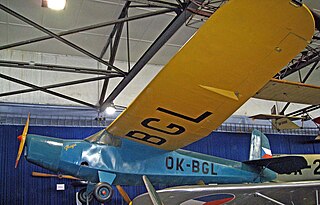
The Percival Gull was a British single-engined monoplane, first flown in 1932. It was successful as a fast company transport, racing aircraft and long-range record breaker. It was developed into the Vega Gull and the Proctor.

The American Champion 8KCAB Decathlon and Super Decathlon are two-seat fixed conventional gear light airplanes designed for flight training and personal use and capable of sustaining aerobatic stresses between +6g and −5g. The Decathlon entered production in the United States in 1970 as a more powerful and stronger complement to the American Champion Citabria line of aircraft.

The Aeronca L was a 1930s American cabin monoplane designed and built, in small numbers, by Aeronca Aircraft. It differed significantly from other Aeronca planes by the use of radial engines, streamlining, and a cantilever low wing.

The Aeronca Model 7 Champion, commonly known as the "Champ", or "Airknocker", is a single-engine light airplane with a high wing, generally configured with fixed conventional landing gear and tandem seating for two occupants.

The E-113 was a small flat-twin piston engine developed by Aeronca for use in some of their light aircraft. It was an overhead valve development of the flathead configuration E-107.

The ANEC I and ANEC II were 1920s British single-engine ultralight aircraft designed and built by Air Navigation and Engineering Company Limited at Addlestone Surrey. One was privately constructed in Brisbane, Australia.

The Luton L.A.4 Minor was a 1930s British single-seat high-wing ultra-light aircraft. The prototype was built by the Luton Aircraft Limited, and design plans were later adapted and copies sold for homebuilding.

The Avions Fairey Junior, also known as the Tipsy Junior was a single-seat light aircraft built in Belgium following World War II.

The Praga E.114 was a single-engine sport airplane, designed and manufactured by the Czechoslovakian company ČKD-Praga. Due to its light weight it was also called Air Baby.

The Curtiss-Wright CW-1 Junior, originally named the Curtiss-Robertson CR-1 Skeeter is a light sports aircraft produced in the United States in the 1930s. It had been intended to sell it for the price of a mid-range automobile.

The Supermarine Sparrow was a British two-seat light sports aircraft designed by R.J. Mitchell and built by Supermarine at Woolston, Southampton.

The Gloster Gannet was a single-seat single-engined light aircraft built by the Gloucestershire Aircraft Company Limited of Cheltenham, United Kingdom, to compete in the 1923 Lympne Trials. Engine development problems prevented it from taking part.

The Chilton D.W.1 is a British light sporting monoplane designed and built in the late 1930s by Chilton Aircraft at Hungerford, Berkshire.

The Slingsby T.29 Motor Tutor was a single-seat motor glider produced from 1948, by Slingsby Sailplanes in Kirbymoorside, Yorkshire.
The Fisher Horizon is a family of Canadian two-seats-in-tandem, conventional landing gear, single-engined, high-wing monoplane kit aircraft designed for construction by amateur builders. The Horizon 1 was inspired by the Aeronca Champion and its later version, the Bellanca Citabria, while the Horizon 2 was inspired by the Cessna O-1 Bird Dog.

The Cranwell CLA.4 was a single-engined two-seat inverted sesquiplane designed and constructed for the 1926 Lympne trials by an amateur group from RAF College Cranwell. Two were entered, though engine problems prevented one from taking part; the other was eliminated with a broken undercarriage. A third aircraft was amateur-built in Canada and flew until 1934.

The Cranwell CLA.3 was a parasol winged single-engined, single-seat British aircraft built to compete in the Lympne air races of 1925. It was designed and built by an amateur group drawn from staff and pupils at the RAF College Cranwell. Though it won one prize and set a Class record, only one CLA.3 was made.

The Spartan C2 is a light aircraft produced in the United States in the early 1930s as a low-cost sport machine that would sell during the Great Depression.

The Aeronca K series, Aeronca Chief, Aeronca Super Chief, Aeronca Tandem, Aeronca Scout, Aeronca Sea Scout, Aeronca Champion and Aeronca Defender were a family of American high-winged light touring aircraft, designed and built starting in the late 1930s by Aeronca Aircraft.

The Turner Two Seat Wot (TSW-2) is a biplane aircraft designed for amateur construction by Chris Turner in 1976.




















